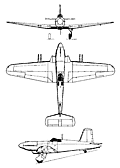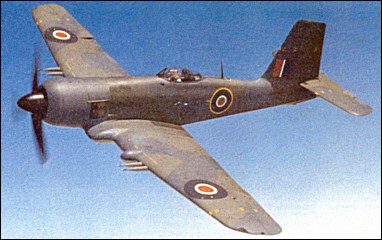|
| The Firebrand was originally designed and built to Specification N.11/40 as a single-seat Fleet fighter powered by the Napier Sabre liquid-cooled engine. Owing to the unavailability of the latter, a new specification was drawn up as S.8/43 to provide for the use of the Bristol Centaurus air-cooled engine. At the same time the requirements of the specification were broadened to provide for a strike role, carrying a torpedo, bombs and/or rockets. Therefore several versions of the Firebrand appeared, although only small numbers of the early types were built.
Production for the FAA began with nine Firebrand F.1 powered by 1,718kW Napier Sabre III engines. These were followed by 12 TF.II powered by similar engines but able to carry an 457mm torpedo; 27 TF.III with 1,878kW Bristol Centaurus IX radial engines; 102 TF.4 with enlarged tail surfaces, wing dive-brakes and other refinements, and powered by the Centaurus IX; and 68 TF.5/5A (plus about 40 TF.4 converted to the later standard) with horn-balanced elevators and other refinements to improve manoeuvrability.
Firebrands entered service with the FAA in September 1945 and so were not used operation-ally during World War II. However Firebrands remained in first-line service until 1953. FACTS AND FIGURES © The Firebrand had an addition;
airspeed indicator mounted
externally so the pilot could fly
the landing approach without
having to look into the cockpit. © To compensate for the torque of
the Centaurus engine, the later
marks had a grotesquely enlarged
tail fin. Powered ailerons on the
final version also helped. © Firebrands were fitted with Sabre
inline and Centaurus radial engines.
The final TF Mk 5A version was
cured of most of the type's fixable
faults, but saw limited service.

| MODEL | B-37 "Firebrand" TF.5 |
| CREW | 1 |
| ENGINE | 1 x Bristol Centaurus IX, 1879kW |
| WEIGHTS |
| Take-off weight | 7938 kg | 17500 lb |
| Empty weight | 5368 kg | 11834 lb |
| DIMENSIONS |
| Wingspan | 15.63 m | 51 ft 3 in |
| Length | 11.81 m | 39 ft 9 in |
| Height | 4.04 m | 13 ft 3 in |
| Wing area | 35.58 m2 | 382.98 sq ft |
| PERFORMANCE |
| Max. speed | 547 km/h | 340 mph |
| Cruise speed | 412 km/h | 256 mph |
| Ceiling | 8685 m | 28500 ft |
| Range | 1190 km | 739 miles |
| ARMAMENT | 4 x 20mm cannons, one torpedo |
 | A three-view drawing (752 x 1051) |
| Make, 17.06.2015 17:29 It is weird to read about British Navy aeroplanes during WW 2. It almost seems that the British weren't aware at all about the development in Japan and US thus flying completely obsolete or at the most mediocre naval fighters and bombers. Fulmars, Fireflys and Barracudas were misguided. When they got what needed, the war was over. reply |
| VinceReeves, 05.03.2013 22:38 The Firebrand had its virtues, reliability and structural strength being the foremost. Its real problem was its unsuitability for deck landing, but that would no doubt have been mitigated if the angled deck had arrived in time.
That said, and contrary to popular belief, there were pilots who liked it - just not the big name ones. reply | | Matthew Kitchen, e-mail, 15.09.2012 10:09 With all the faults with this plane; Firepest seems more like it. reply | | edward gowing, e-mail, 19.02.2012 12:33 HMS Indomitable 1951 we had a squadron of centaurus firebrands on board. A most impreeive plane. They had foue bladed wooden props that splintered a d flew everywhere if a 'brand' hit the barrier. One mane was killed walking through a boat space two decks below when a piece of prop boomeranged out and hit hishead. after that no one was allowed in open spaces when 'branda' were landing on. reply | |
| | George, e-mail, 30.06.2010 22:49 I like the lines of this aircraft. True, it was not a great performer, but I still like it.
I'm building one as a free flight rubber powered.
A tip of the hat to everyone involved in this program.
I'm not British, I'm a Yank, but I find British aircraft of this era, far more interesting than ours.
Next; a Wyvern... reply | | Klaatu83, e-mail, 05.07.2010 20:05 Although Blackburn has come in for a lot of criticism over this airplane, in truth a lot of the blame belongs to the customer (the Royal Navy). They asked Blackburn to produce a single-seat carrier-based fighter powered by a Napier Sabre engine, which they did. Next the Navy requested that it be re-designed as a torpedo-bomber, and again Blackburn complied. Then the Navy decided that they wanted the Bristol Centaurus radial engine instead of the liquid-cooled Sabre. Once again Blackburn complied. Considering all the engineering changes the firm had to contend with to keep with the Navy's changing demands, it's a wonder that this aircraft ever entered service at all! reply | | Steve, e-mail, 12.08.2009 18:57 To illustrate the subtleties of design: The original F.1 interceptor was a bit better than the Grumman Hellcat in both power-to-weight ratio and wing loading (!?) And I have to say that the prospect of prolonged overwater flight behind a Sabre would have been alarming. reply | | Leo Rudnicki, e-mail, 21.05.2009 03:03 Per: Winkle Brown, this was a bad airplane /combat A /C / naval shipboard A /C. Blackburn's contribution to the war effort seems to have been Stringbag production. Firecrest was an attempt to make it a better shipboard airplane in the jet age. They only used them in service because they were no good as target tugs. reply |
|
Do you have any comments?
|
| 
COMPANY
PROFILE
All the World's Rotorcraft
|









Fortunately, the Kriegsmarine couldn't find their asses with two hands.
reply